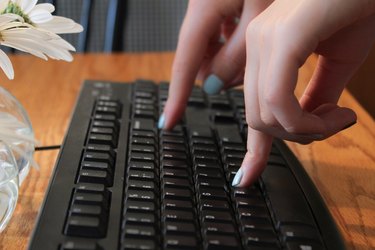
Whether you've never used a computer keyboard or you're a veteran looking to improve your typing skills, there are numerous tips and techniques that can make using a keyboard far easier. Memorizing where each letter is located is crucial to typing at a faster pace.
F and J Guidance
Video of the Day

The most common method, and arguably the easiest, for remembering the keys on a keyboard is to use the F and J keys as reference points. On most American keyboards, these keys have small, raised bumps on them. If you close your eyes, you can feel around the keyboard to identify the F and J keys. Because you don't need to memorize these, place your pointer fingers on them and move the others in random directions, gradually trying to remember the letters that surround those two. It'll take time and effort, but eventually maneuvering your fingers around the F and J keys to type other letters will feel natural.
Video of the Day
Use All Fingers

A common mistake among beginners is to start out using two fingers, often the pointer fingers, and punching each letter with just those two fingers. Eventually, some people get accustomed to typing this way, which prevents them from being able to type at maximum speed. It's comparable to riding a bike with training wheels and never taking them off. Be sure that when you type, you don't keep typing with the same two fingers and that you aren't staring at the keyboard the entire time. Spread out all 10 fingers and make use of them.
Additionally, no one finger should wander too far from where you originally placed it on the keyboard. It'll become far easier to type if each finger gets a designated typing area. For instance, try reserving your two thumbs for the space bar and placing your other fingers on the A, S, D, F, J, K, L and ; keys. Make each finger responsible for the key it is on as well as the surrounding keys. The left pinkie, for example, should be responsible for the Q and Z keys above and below the letter A. The left ring finger should take on W and X as well as S, and so on.
Online Keyboard Tutorials

If you want a bit of outside help, try an online typing tutorial. They're often free and quite helpful for memorizing the placement of letters on a computer keyboard without being too time consuming. One example is the Sense-lang keyboard tutorial and typing test, which offers 16 progressively challenging exercises. Another is TypingWeb, which has full courses based on your current level of expertise.
Typing Games

Practice makes perfect, but you can have fun while you're practicing. There are plenty of online games that can improve your keyboard skills and memory without you even realizing it. One such game is TypeRacer, which gives you a randomly generated paragraph to type in a race against other players. You can view the whole paragraph at once or choose to view it line by line as you type. Typing Test also has two games on its website, Key Man and Key Tower, both with the purpose of building up keyboard expertise. These are just a few examples, but many are available online and for free to get started.